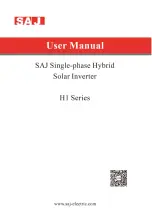
1
1-313
Leak Test
(1) With the service valves on the outdoor unit closed, remove the 6.35 mm flare nut and its bonnet on the gas tube
service valve. (Save for reuse.)
Evacuation
Be sure to use a vacuum pump that includes a function for prevention of back-flow, in order to prevent back-flow of
ump oil into the unit tubing when the pump is stopped.
(1) Attach the charge hose end described in the preceding
steps to the vacuum pump to evacuate the tubing and
indoor unit. Confirm that the “Lo” knob of the manifold
valve is open. Then, run the vacuum pump.
(2) When the desired vacuum is reached, close the “Lo” knob
of the manifold valve and turn off the vacuum pump.
Confirm that the gauge pressure is under –101 kPa
{–755 mmHg, 5 Torr} after 4 to 5 minutes of vacuum pump
operation.
(2) Attach a manifold valve (with pressure gauges) and dry nitrogen gas cylinder to this service port with charge
hoses.
(3) Pressurize the system up to 4.15 MPa {42 k
g
f/cm
2
G} with dry nitrogen gas and close the cylinder valve
when the gauge reading reaches 4.15 MPa {42 k
g
f/cm
2
G}.
Then, test for leaks with liquid soap.
(4) Do a leak test of all joints of the tubing (both indoor and outdoor) and both gas and liquid service valves.
Bubbles indicate a leak. Wipe off the soap with a clean cloth after a leak test.
(5) After the system is found to be free of leaks, relieve the nitrogen pressure by loosening the charge hose
connector at the nitrogen cylinder. When the system pressure is reduced to normal, disconnect the hose from
the cylinder.
CAUTION
Use a manifold valve for air purging. If it is not available, use a stop valve for this purpose.
The “Hi” knob of the manifold valve must always be kept closed.
CAUTION
To avoid nitrogen entering the refrigerant system in a liquid state, the top of the cylinder must be
higher than the bottom when you pressurize the system. Usually, the cylinder is used in a vertical
standing position.
Perform vacuuming of the indoor unit and tubing.
Connect the vacuum pump to the gas tube valve and
apply vacuum at a pressure of –101kPa {–755 mmHg,
5 Torr} or below.
Continue vacuum application for a minimum of 1 hour after
the pressure reaches –101kPa {–755 mmHg, 5 Torr}.
CAUTION
Use a cylinder specifically designed for use with R410A.
Lo
Hi
Manifold valve
Pressure
gauge
Vacuum pump
Open
Close
Gas tube
Liquid tube
Outdoor unit
Close
SM830211-07̲PAC-i.indb 313
SM830211-07̲PAC-i.indb 313
2013/09/17 22:48:03
2013/09/17 22:48:03
Summary of Contents for U-100PEY1E5
Page 536: ... MEMO 1 526 ...
Page 540: ... MEMO 2 4 ...
Page 549: ...3 9 3 3 1 Indoor Units Ducted Type S 36PN1E5 S 45PN1E5 S 50PN1E5 Electric Wiring Diagram ...
Page 551: ...3 11 3 3 2 Outdoor Units Single phase U 50PE1E5 ...
Page 552: ...3 12 3 3 2 Outdoor Units Single phase U 50PE1E5 ...
Page 553: ...3 13 3 3 2 Outdoor Units Single phase U 60PE1E5 U 71PE1E5 䡵 ...
Page 554: ...3 14 3 3 2 Outdoor Units Single phase U 100PE1E5 U 125PE1E5 U 140PE1E5 䡵 ...
Page 555: ...3 15 3 3 2 Outdoor Units Single phase U 60PEY1E5 U 71PEY1E5 ...
Page 556: ...3 16 3 3 2 Outdoor Units Single phase U 60PEY1E5 U 71PEY1E5 ...
Page 558: ...3 18 3 3 2 Outdoor Units 3 phase U 71PE1E8 ...
Page 559: ...3 19 3 3 2 Outdoor Units 3 phase U 100PEY1E8 U 125PEY1E8 ...
Page 560: ...3 20 3 3 2 Outdoor Units 3 phase U 100PE1E8 U 125PE1E8 U 140PE1E8 U 140PEY1E8 ...
Page 594: ...4 34 4 HIC PCB A746895 U 60PE1E5 U 71PE1E5 CN VDC U P V W N CN VDC 4WAY Valve CN 20S ...
Page 595: ...4 35 4 HIC PCB continued A746846 U 100PE1E5 CN VDC U V W CN VDC 4WAY Valve CN 20S P NU ...
Page 597: ...4 37 4 HIC PCB A746846 U 100PEY1E5 CN VDC U V W CN VDC 4WAY Valve CN 20S P NU ...
Page 598: ...4 38 4 HIC PCB continued A746847 U 125PEY1E5 CN VDC U V W CN VDC 4WAY Valve CN 20S P NU ...
Page 602: ...4 42 4 HIC PCB A747248 U 100PEY1E8 U 125PEY1E8 CN VDC U V W CN VDC 4WAY Valve CN 20S P NU ...
Page 738: ... MEMO 8 34 ...
Page 739: ...201309 ...
















































